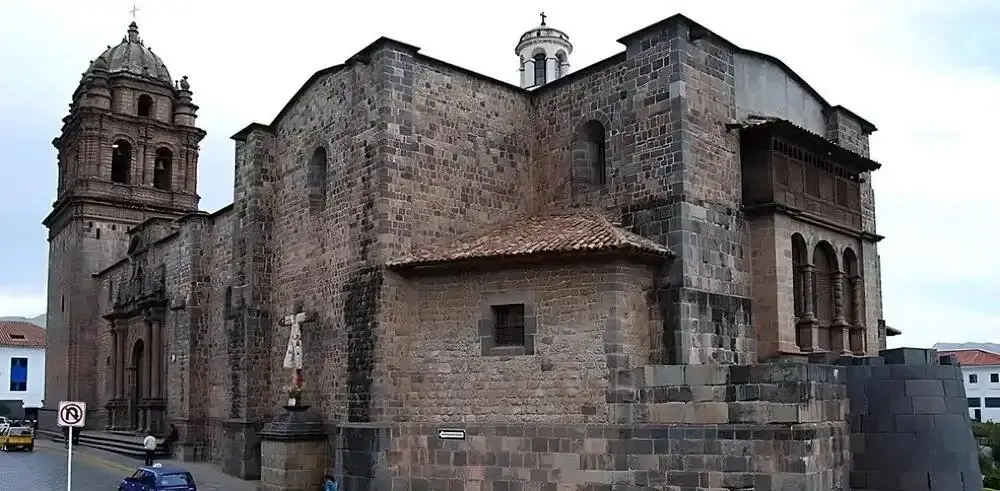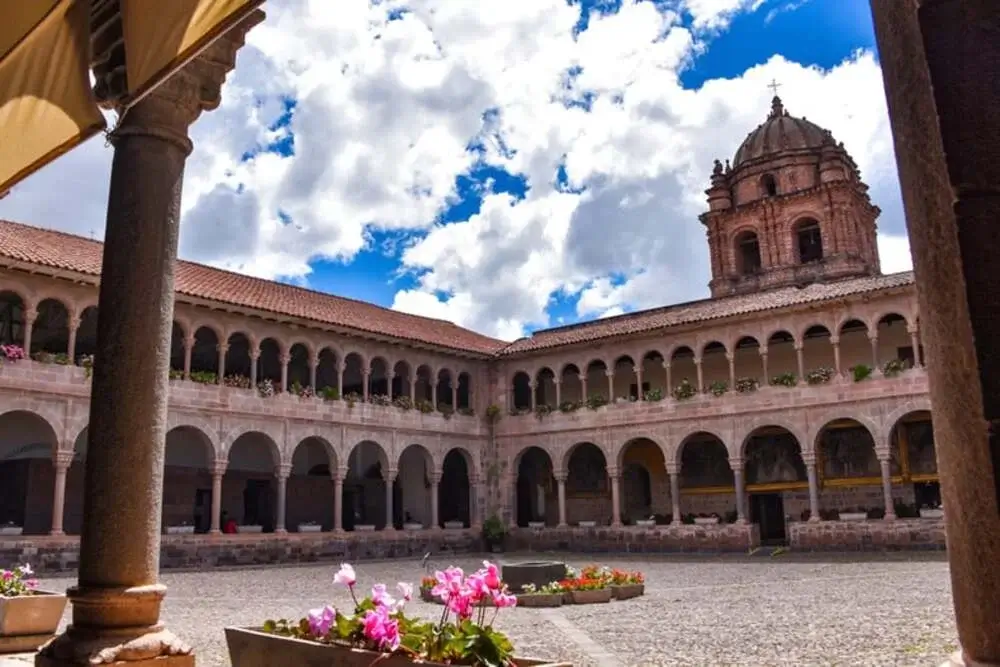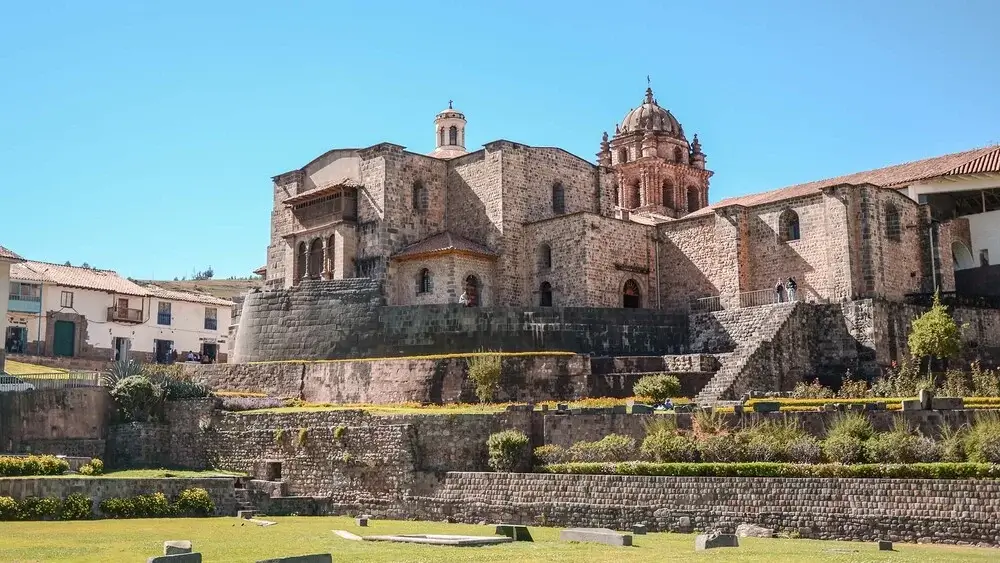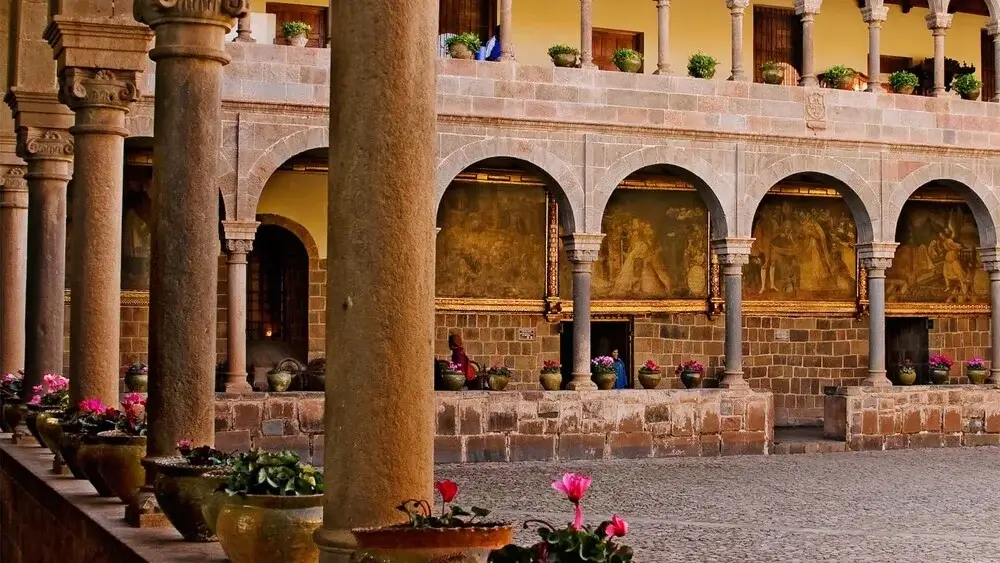In the heart of Cusco, a city once considered the center of the Inca Empire, stands one of Peru’s most fascinating treasures: Qoricancha, the Temple of the Sun. Once the most revered temple in the Inca world, it was a dazzling masterpiece of precision stonework, covered in sheets of pure gold that reflected the Andean sun. Today, it remains a captivating blend of Inca engineering and Spanish colonial architecture, telling a story of power, faith, and resilience.
For travelers seeking not just a destination but an immersion into history, Qoricancha offers a window into the spiritual and cultural soul of the Incas and an essential stop in any Cusco itinerary.
1. What is Qoricancha?
The name Qoricancha comes from the Quechua words quri (gold) and kancha (enclosure), translating to “Golden Enclosure.” This was no poetic exaggeration according to historical accounts, its walls once shimmered with sheets of pure gold, reflecting the sun in dazzling brilliance. Located in the heart of Cusco, the capital of the Inca Empire, Qoricancha was considered the most sacred site in Tawantinsuyo, the vast realm that stretched from present-day Colombia to Chile.
Primarily dedicated to Inti, the Sun God and divine ancestor of the Inca rulers, the temple was also home to shrines honoring other important celestial and natural deities: the Moon (Quilla), the Stars (Chaska), the Rainbow (K’uychi), and Lightning (Illapa). These deities formed an interconnected spiritual system that reflected the Inca worldview, in which cosmic order, nature, and society were deeply intertwined. Qoricancha thus functioned not only as a place of worship but also as a symbol of imperial power and divine legitimacy.
2. The Historical Significance of Qoricancha
Qoricancha was more than a temple it was a religious, political, and astronomical nerve center for the entire Inca Empire. Its construction is attributed to earlier rulers, but it reached its height of splendor during the reign of Emperor Pachacutec in the 15th century, a period when Cusco was redesigned into the shape of a puma, with Qoricancha at its symbolic heart.
Spanish chroniclers recounted sights of unmatched luxury: ceremonial halls adorned with life-size human, llamal, and maize plant statues made entirely of precious metals, interior walls lined with sheets of gold. These were sacrifices to the gods, not just ornaments, and were intended to promote cosmic harmony, political stability, and agricultural fertility. There were also thoughtfully planned gardens on the temple grounds.
3. Architectural Highlights & Sacred Enclosures
Inside Qoricancha, visitors will find several distinct chambers, each dedicated to a specific deity:
- Temple of the Sun: The main shrine, with perfectly fitted stones and once lined with gold.
- Temple of the Moon: Dedicated to Mama Killa, the Moon goddess.
- Temple of the Stars: Honoring celestial daughters of the Sun and Moon.
- Temple of the Rainbow: Associated with rain and fertility.
- Temple of Lightning (Illapa): Devoted to thunder, lightning, and rain.
- Sacrifice Chamber: Featuring stone tables used for ceremonial offerings.
- Sacred Gardens: Once filled with gold and silver flora and fauna.
- Ceremonial Fountain: Believed to have held ritual significance.
4. Visiting Qoricancha: Location, Hours, and Tickets
- Address: Av. El Sol 526, Cusco – just an 8-minute walk from the Plaza de Armas.
- Altitude: 3,390 m (11,120 ft) above sea level.
- Opening Hours:
- Monday–Saturday: 8:30 am – 5:30 pm
- Sundays: Closed (verify locally as hours may change).
- Tickets: Part of the Cusco Tourist Ticket or available as a separate entry ticket.
5. Cultural and Astronomical Importance
Qoricancha was far more than a temple it was a sophisticated cosmic observatory at the very heart of Inca civilization. Its carefully engineered walls, niches, and windows were aligned with key astronomical events such as the solstices and equinoxes. During these moments, sunlight would enter the temple in precise ways, illuminating specific altars or sacred spaces, signaling important times in the Inca calendar.
Priests, who were also skilled astronomers, used these alignments to track the passage of time and mark the change of seasons. This knowledge was vital for determining the most favorable periods for planting and harvesting, as well as for scheduling major religious ceremonies honoring Inti (the Sun) and other deities.
Beyond its practical agricultural function, Qoricancha’s astronomical design reflected the Inca worldview, where the cosmos, nature, and human life were deeply interconnected. The temple was a physical representation of the Inca’s sacred order of the universe, linking the heavens, the earth, and the underworld in a single harmonious structure.
6. The Spanish Conquest and Transformation into Santo Domingo
Following the Spanish conquest in the 16th century, Qoricancha’s splendor was systematically stripped away. The vast quantities of gold and silver that once adorned its walls, altars, and courtyards were removed and melted down, much of it sent to Spain as part of the colonial treasure. What had been the most sacred space of the Inca Empire was repurposed to serve the new colonial order.
In order to symbolize the victory of Christianity over the Inca religion, the Dominicans built the Convent of Santo Domingo exactly on top of Qoricancha's foundations in the middle of the fifteenth century. The old Inca stonework known for its exquisite accuracy remains intact beneath and surrounding the colonial buildings in spite of the drastic change.
Over the centuries, the region was struck by powerful earthquakes that severely damaged or destroyed much of the colonial building. Remarkably, the Inca walls endured, standing as silent proof of the extraordinary engineering skills of the Inca stonemasons. Today, the site represents a striking blend of two worlds: the enduring legacy of Inca architecture and the imposing presence of Spanish colonial design, layered together in a single monumental space.
7. Qoricancha Today – What to See Inside
Visitors can explore:
- Original Inca walls and trapezoidal doors.
- Museum rooms displaying Inca artifacts.
- The cloisters of the colonial convent.
- Archaeological models explaining the site’s history.
8. Travel Tips from Andean Travel Experience
- Best Time to Visit: Early morning for fewer crowds and better light for photography.
- Altitude Prep: Spend a day or two acclimatizing in Cusco before your visit.
- Guided Tours: Enhance your visit with expert local guides to understand its symbolic meaning.
- Photography: Tripods are not allowed, but phone and handheld cameras are fine.
9. Nearby Attractions & Suggested Itineraries
Pair your visit with:
- Cusco Cathedral – 8 min walk
- San Pedro Market – 12 min walk
- Sacsayhuamán – 20 min drive
- Sacred Valley Tours – Full-day trips from Cusco
10. How to Combine Qoricancha with Machu Picchu
A perfect itinerary could be:
- Day 1: Arrive in Cusco, visit Qoricancha and city highlights.
- Day 2: Sacred Valley tour.
- Day 3: Machu Picchu visit via train from Ollantaytambo.
11. Frequently Asked Questions about Qoricancha
Can I visit Qoricancha with children?
Yes! Qoricancha is family-friendly and offers easy walking paths suitable for children. It’s a great opportunity to introduce young ones to Inca history and culture in an engaging setting. Just keep an eye on uneven surfaces in some areas.
How long should I plan for a visit?
Most visitors spend between 1 and 2 hours exploring the temple and its museum. This allows enough time to appreciate the architecture, learn about the history, and enjoy the exhibits without feeling rushed.
Is Qoricancha accessible for people with mobility challenges?
While the site has some uneven stone floors and steps, staff can provide assistance and advice for visitors with mobility needs. It’s best to contact the administration in advance to arrange support or accommodations.
Are guided tours available at Qoricancha?
Yes, guided tours are highly recommended to gain deeper insight into the temple’s history, cultural significance, and architectural marvels. Many local guides and tour companies offer expert-led visits.
What is the best time of day to visit Qoricancha?
Morning visits are ideal to avoid larger crowds and to enjoy the soft sunlight illuminating the temple’s features. Early afternoon can also be pleasant, but late afternoons tend to be busier.
Is there an entrance fee to visit Qoricancha?
Yes, there is a modest entrance fee which helps maintain and preserve the site. Prices can vary for locals, students, and foreign tourists, so check the current rates before your visit.
Can I take photographs inside Qoricancha?
Photography is generally allowed, but the use of flash or tripods may be restricted to protect the artifacts. It’s always best to check on-site rules and respect any signage.
Are there any special events or ceremonies held at Qoricancha today?
Occasionally, cultural events and traditional ceremonies are held to celebrate Inca heritage. Check local event calendars or ask at the visitor center for any scheduled activities during your visit.
The Qoricancha Temple is more than just an archaeological site it’s a living testament to the ingenuity, artistry, and spirituality of the Inca civilization. From its precision-cut stone walls to its sacred gardens and symbolic chambers, Qoricancha invites travelers to connect with centuries of history in the heart of Cusco. Whether you are an archaeology enthusiast, a culture lover, or a family seeking to immerse yourself in Peru’s rich heritage, this site offers an unforgettable journey through time.
Ready to walk in the footsteps of the Incas and experience the magic of Qoricancha for yourself?
Book your personalized Cusco tour with Andean Travel Experience today and enjoy expert guidance, insider access, and unforgettable moments. Your journey into Peru’s most treasured wonders starts here.




